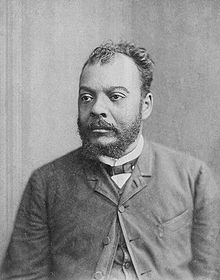
DomPedro II, nicknamed the Magnanimous, was the second and last monarch of the Empire of Brazil, reigning for over 58 years. He was born in Rio de Janeiro, the seventh child of Emperor Dom Pedro I of Brazil and Empress Dona Maria Leopoldina and thus a member of the Brazilian branch of the House of Braganza. His father's abrupt abdication and departure to Europe in 1831 left the five-year-old as emperor and led to a grim and lonely childhood and adolescence, obliged to spend his time studying in preparation for rule. His experiences with court intrigues and political disputes during this period greatly affected his later character; he grew into a man with a strong sense of duty and devotion toward his country and his people, yet increasingly resentful of his role as monarch.

The Empire of Brazil was a 19th-century state that broadly comprised the territories which form modern Brazil and Uruguay. Its government was a representative parliamentary constitutional monarchy under the rule of Emperors Pedro I and his son Pedro II. A colony of the Kingdom of Portugal, Brazil became the seat of the Portuguese Empire in 1808, when the Portuguese Prince regent, later King Dom John VI, fled from Napoleon's invasion of Portugal and established himself and his government in the Brazilian city of Rio de Janeiro. John VI later returned to Portugal, leaving his eldest son and heir-apparent, Pedro, to rule the Kingdom of Brazil as regent. On 7 September 1822, Pedro declared the independence of Brazil and, after waging a successful war against his father's kingdom, was acclaimed on 12 October as Pedro I, the first Emperor of Brazil. The new country was huge, sparsely populated and ethnically diverse.
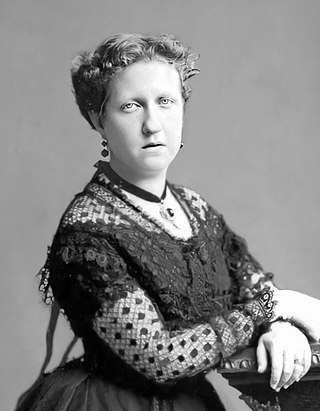
DonaIsabel, nicknamed "the Redemptress", was the Princess Imperial of the Empire of Brazil and the Empire's regent on three occasions. Born in Rio de Janeiro as the eldest daughter of Emperor Pedro II of Brazil and Empress Teresa Cristina, she was a member of the Brazilian branch of the House of Braganza. After the deaths of her two brothers in infancy, she was recognized as her father's heir presumptive. She married a French prince, Gaston, Count of Eu, in an arranged marriage and they had three sons.

Prince Pedro Henrique of Orléans-Braganza, nicknamed The Expected Prince was a son of Prince Luis Maria of Brazil and Princess Maria di Grazia of Bourbon-Two Sicilies. He assumed the leadership of the Imperial House of Brazil between 1921 and 1981, after the death of his grandmother, Isabel, Princess Imperial of Brazil.

DomPedro de Alcântara of Orléans-Braganza, Prince of Grão Pará was the first-born son of Dona Isabel, Princess Imperial of Brazil and Prince Gaston of Orléans, Count of Eu, and as such, was born second-in-line to the imperial throne of Brazil, during the reign of his grandfather, Emperor Dom Pedro II, until the empire's abolition. He went into exile in Europe with his mother when his grandfather was deposed in 1889, and grew up largely in France, at a family apartment in Boulogne-sur-Seine, and at his father's castle, the Château d'Eu in Normandy.

Dona Teresa Cristina, nicknamed "the Mother of the Brazilians", was Empress of Brazil as the consort of Emperor Dom Pedro II from their marriage on 30 May 1843 until 15 November 1889, when the monarchy was abolished. Born a princess of the Kingdom of the Two Sicilies in present-day southern Italy, Teresa Cristina was the daughter of King Don Francesco I (Francis I) of the Italian branch of the House of Bourbon and his wife Maria Isabel. It was long believed by historians that the Princess was raised in an ultra-conservative, intolerant atmosphere which resulted in a timid and unassertive character in public and an ability to be contented with very little materially or emotionally. Recent studies revealed a more complex character, who despite having respected the social norms of the era, was able to assert a limited independence due to her strongly opinionated personality as well as her interest in learning, sciences and culture.

The House of Orléans-Braganza is a cadet branch of the French House of Orléans and the name of the deposed Imperial House of Brazil formed from the marriage between Isabel, Princess Imperial of Brazil, of the House of Braganza, and Prince Gaston, Count of Eu, of the House of Orléans, in 1864. The House of Orléans-Braganza never reigned, as Brazil's pure Braganza monarch, Emperor Pedro II being deposed in a military coup d'état, under the pressure of the civilian republicans, in 1889. However, with the death of Isabel in 1921, as the last Brazilian pure Braganza, her descendants inherited the dynastic rights of the Brigantine dynasty over the defunct Brazilian throne.

Dona Paula was a princess of the Empire of Brazil and thus, a member of the Brazilian branch of the Portuguese House of Braganza. Her parents were Emperor Dom Pedro I, the first ruler of an independent Brazil, and Archduchess Leopoldina of Austria. Born in Rio de Janeiro, Paula was the couple's fifth child and third daughter child; she lost her mother at the age of three and her father at the age of eight, when he abdicated and left Brazil for Portugal, where he wanted to restore the throne of Paula's eldest sister, Maria da Glória, who should have become queen regnant of Portugal.

Dona Maria Amélia was a princess of the Empire of Brazil and a member of the Brazilian branch of the House of Braganza. Her parents were Emperor Dom Pedro I, the first ruler of Brazil, and Amélie of Leuchtenberg. The only child of her father's second marriage, Maria Amélia was born in France after Pedro I abdicated the Brazilian throne in favor of his son Dom Pedro II. Before Maria Amélia was a month old, Pedro I went to Portugal to restore the crown of the eldest daughter of his first marriage, Dona Maria II. He fought a successful war against his brother Miguel I, who had usurped Maria II's throne.

Dom Afonso was the Prince Imperial and heir apparent to the throne of the Empire of Brazil. Born in Rio de Janeiro, he was the eldest child of Emperor Dom Pedro II and Dona Teresa Cristina of the Two Sicilies, and thus a member of the Brazilian branch of the House of Braganza.
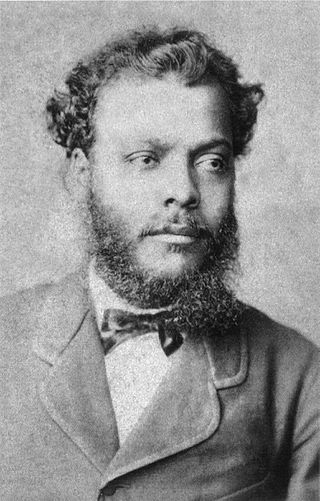
José Carlos do Patrocínio was a Brazilian writer, journalist, activist, orator and pharmacist. He was among the most well-known proponents of the abolition of slavery in Brazil, and known as "Tigre da Abolição". He founded and occupied the 21st chair of the Brazilian Academy of Letters from 1897 until his death in 1905.
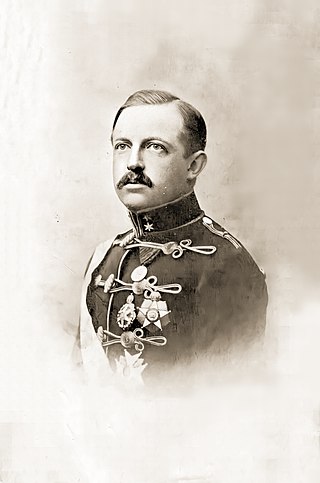
Luís of Orléans-Braganza, was a claimant to the former throne of the Empire of Brazil. He was born in Brazil, the second son of Prince Gaston, Count of Eu, and Isabel, Princess Imperial of Brazil.
Movimento Negro is a generic name given to the diverse Afro-Brazilian social movements that occurred in 20th-century Brazil, particularly those movements that appeared in post-World War II Rio de Janeiro and São Paulo.

The legacy of Pedro II of Brazil became apparent soon after his death. Emperor Pedro II was the second and last monarch of the Empire of Brazil, whose long 58-year reign (1831–1889) represented a time of remarkable prosperity and progress for his country. Despite his achievements, he was deposed in a coup by disgruntled republicans, though there was no desire for a change in the form of government among the majority of the Brazilian people.

The decline and fall of Pedro II of Brazil took place in the 1880s. It coincided with a period of economic and social stability and progress for the Empire of Brazil, with the nation achieving a prominent place as an emerging power in the international arena.

Dom Pedro Afonso was the Prince Imperial and heir apparent to the throne of the Empire of Brazil. Born at the Palace of São Cristóvão in Rio de Janeiro, he was the second son and youngest child of Emperor Dom Pedro II and Dona Teresa Cristina of the Two Sicilies, and thus a member of the Brazilian branch of the House of Braganza. Pedro Afonso was seen as vital to the future viability of the monarchy, which had been put in jeopardy by the death of his older brother Dom Afonso almost three years earlier.
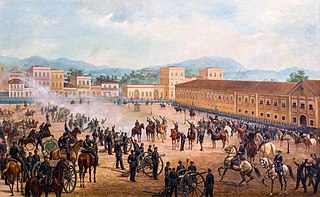
The Proclamation of the Republic was a military coup d'état that established the First Brazilian Republic on November 15, 1889. It took over the constitutional monarchy of the Empire of Brazil and ended the reign of Emperor Pedro II.

The Imperial Brazilian Army was the name given to the land force of the Empire of Brazil. The Brazilian Army was formed after the independence of the country from Portugal in 1822 and reformed in 1889, after the republican coup d'état that created the First Brazilian Republic, a dictatorship headed by the army.

Diretório Monárquico do Brasil was a monarchical institution established in Rio de Janeiro in 1890, one year after the proclamation of the republic, by Afonso Celso de Assis Figueirado, The Viscount of Ouro Preto, the last Prime Minister of the Empire of Brazil, entrusted by the former Princess Regent Isabel, to whom they considered Empress of Brazil after the death of their father Pedro II, in 1891, to organize the actions of Brazilian monarchists. The organization was constituted as an unofficial representation of the deposed heiress to the throne of Brazil and also functioned as a council.
